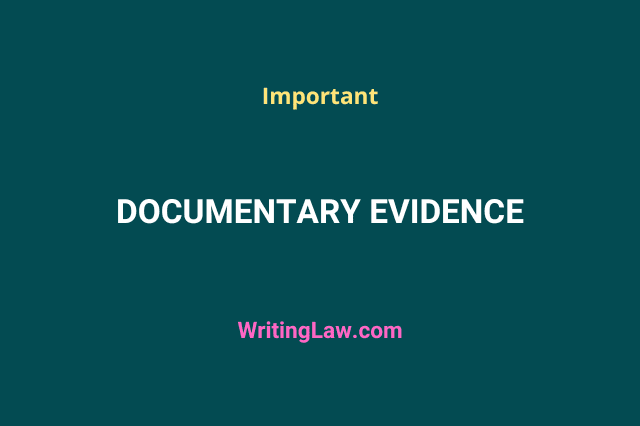
The facts may either be proved by oral evidence or documentary evidence. Documentary evidence is the second way of proving the facts.
The term “documentary evidence” is defined under section 3 of the Indian Evidence Act. However, the provisions related to documentary evidence are given under sections 61 to 90A of Chapter 5 of the Evidence Act.
In the new Bharatiya Sakshya Adhiniyam, 2023, documentary evidence is mentioned primarily under Chapter 5.
Definition of Documentary Evidence
According to section 3 of the law of evidence, documentary evidence is the documents produced for the court’s inspection. Additionally, anything with a permanent record of a relevant fact or a fact in question is referred to as a document in this context. The document should not be interpreted in a restrictive manner.
For example, a map and photographs are documents. Recorded tapes are also considered documents, and hence, they can be presented as documentary evidence before the court.
Kinds of Documents
The evidence presented in the court for the inspection in writing or written format is considered documentary evidence. The documentary evidence is basically of two types:
- Private Documents
- Public Documents
Private Documents
Section 75 of the Evidence Act provides that all documents other than public documents are private documents. Basically, documents that do not come under the purview of section 76 of the Evidence Act are private documents.
Public Documents
The documents that a public official has verified are considered public documents. As given in section 74 of the Evidence Act, public documents are the documents that represent the acts or records of the acts of the sovereign authority or official bodies and tribunals or public officials, including legislative, judicial and executive of any portion of India, the Commonwealth, or a foreign nation. It also includes any private documents that are registered in public offices as public documents.
Public documents are always proved by certified copies, i.e. secondary evidence.
Related Law Note: 7 Differences Between Public and Private Documents
Proof of Contents of Documents
Section 61 of the law of evidence contains provisions about proof of contents of documents. Accordingly, the contents of the document can be proved by producing either:
- Primary evidence, or
- Secondary evidence
Related Law Note: What Is Primary And Secondary Evidence
Primary Evidence
The first method of proving the contents of the document is by producing the original document, i.e. the document itself. Primary evidence is defined under section 62 of the Evidence Act. Primary evidence contains:
- The original document produced for the court’s inspection.
- Each part of the document serves as primary evidence if the document is executed in several parts.
- If a document is produced in several counterparts, each is the primary evidence against the party that signed it.
- When several documents are introduced using a single, consistent method, such as printing, lithography, or photography, each is the primary evidence of the document’s contents.
Section 64 further provides the principle that the evidence must always be proved by producing primary evidence before the court.
Secondary Evidence
Secondary evidence, as defined in section 63 of the Evidence Act, includes certified copies of the original documents, mechanically created copies derived from the original documents, copies produced or compared from the original document, and counterparts of a document presented against the person who did not sign it. Oral statements of the document’s contents provided by a person who has personally viewed the document are also regarded as secondary documents.
Section 65 further provides the exception to the principle laid down in section 64 of the Evidence Act. As stated in section 64, evidence must always be proved by producing primary documents. However, section 65 contains some instances in which evidence can be proved even by producing secondary evidence.
The cases under which secondary evidence can be present before the court for inspection are:
- When the original document appears or is in the ownership or control of a person against whom the evidence is sought, a person who is out of reach, immune from legal process, or otherwise legally obligated to produce the original document.
- When the party against whom the document is to be proved has confirmed its existence, condition, or contents in writing.
- When the original document is lost or destroyed, or when the party providing evidence cannot furnish it within a reasonable amount of time for any cause other than his fault or negligence.
- When the document is immovable or cannot be moved conveniently, such as when writing is on a wall.
- When the document is a public document.
- When the document is such that it is permitted by the Evidence Act or any other law in India to be admissible as evidence.
- When the document contains several accounts or other documents that cannot be appropriately examined in the court.
Further, if the original document is in the opponent’s control, he must be given notice to produce it. Secondary evidence will only be admitted if the opponent neglects the notice.
Where the original document is lost or destroyed, secondary evidence is only admitted when the loss or the destruction has been proved.
- Understanding the Legislative Branch of the Indian Government - 6th May 2024
- Appointment, Oath, and Removal of Constitutional Posts in India - 28th April 2024
- Powers of Income Tax Authorities in India - 26th April 2024







